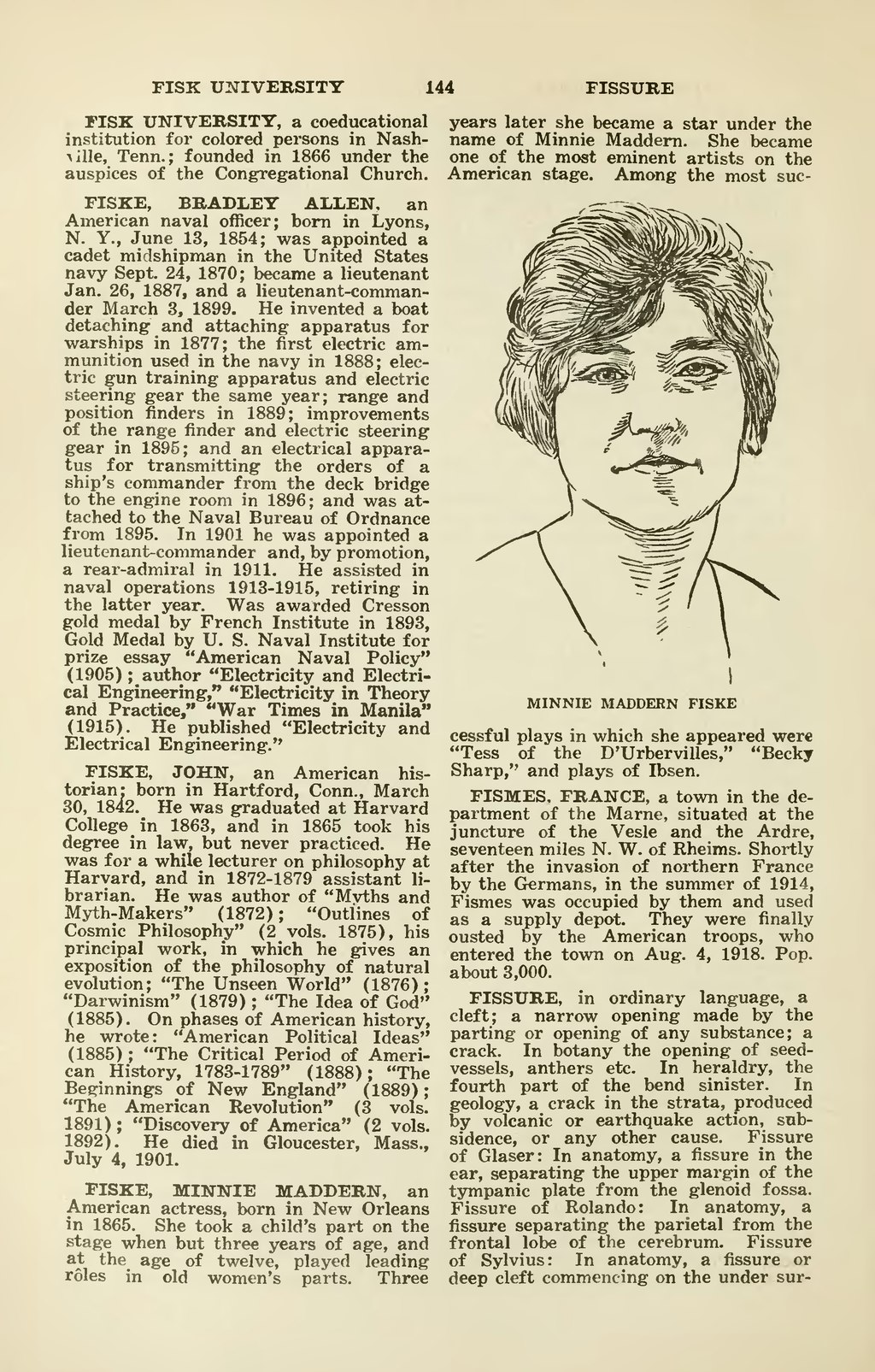FISK UNIVERSITY 144 FISSURE FISK UNIVERSITY, a coeducational years later she became a star under the institution for colored persons in Nash- name of Minnie Maddern. She became ^ille, Tenn. ; founded in 1866 under the one of the most eminent artists on the auspices of the Congregational Church. American stage. Among the most suc- FISKE, BRADLEY ALLEN, an American naval officer; bom in Lyons, N. Y., June 13, 1854; was appointed a cadet midshipman in the United States navy Sept. 24, 1870; became a lieutenant Jan. 26, 1887, and a lieutenant-comman- der March 3, 1899. He invented a boat detaching and attaching apparatus for warships in 1877; the first electric am- munition used in the navy in 1888; elec- tric gun training apparatus and electric steering gear the same year; range and position finders in 1889; improvements of the range finder and electric steering gear in 1895; and an electrical appara- tus for transmitting the orders of a ship's commander from the deck bridge to the engine room in 1896; and was at- tached to the Naval Bureau of Ordnance from 1895. In 1901 he was appointed a lieutenant-commander and, by promotion, a rear-admiral in 1911. He assisted in naval operations 1913-1915, retiring in the latter year. Was awarded Cresson gold medal by French Institute in 1893, Gold Medal by U. S. Naval Institute for prize essay "American Naval Policy" (1905) ; author "Electricity and Electri- cal Engineering,** "Electricity in Theory and Practice," "War Times in Manila" (1915). He published "Electricity and Electrical Engineering." FISKE, JOHN, an American his- torian; born in Hartford, Conn., March 30, 1842. He was graduated at Harvard College in 1863, and in 1865 took his degree in law, but never practiced. He was for a while lecturer on philosophy at Harvard, and in 1872-1879 assistant li- brarian. He was author of "Mvths and Myth-Makers" (1872) ; "Outlines of Cosmic Philosophy" (2 vols. 1875), his principal work, in which he gives an exposition of the philosophy of natural evolution; "The Unseen World" (1876); "Darwinism" (1879) ; "The Idea of God" (1885). On phases of American history, he wrote: "American Political Ideas" (1885) ; "The Critical Period of Ameri- can History, 1783-1789" (1888); "The Beginnings of New England" (1889) ; "The American Revolution" (3 vols. 1891) ; "Discovery of America" (2 vols. 1892). He died in Gloucester, Mass., July 4, 1901. FISKE, MINNIE MADDERN, an American actress, born in New Orleans in 1865. She took a child's part on the stage when but three years of age, and at the age of twelve, played leading roles in old women's parts. Three MINNIE MADDERN FISKE cessful plays in which she appeared were "Tess of the D'Urbervilles," "Becky Sharp," and plays of Ibsen. FISMES, FRANCE, a town in the de- partment of the Marne, situated at the juncture of the Vesle and the Ardre, seventeen miles N. W. of Rheims. Shortly after the invasion of northern France by the Germans, in the summer of 1914, Fismes was occupied by them and used as a supply depot. They were finally ousted by the American troops, who entered the town on Aug. 4, 1918. Pop. about 3,000. FISSURE, in ordinary language, a cleft; a narrow opening made by the parting or opening of any substance; a crack. In botany the opening of seed- vessels, anthers etc. In heraldry, the fourth part of the bend sinister. In geology, a crack in the strata, produced by volcanic or earthquake action, sub- sidence, or any other cause. Fissure of Glaser: In anatomy, a fissure in the ear, separating the upper margin of the tympanic plate from the glenoid fossa. Fissure of Rolando: In anatomy, a fissure separating the parietal from the frontal lobe of the cerebrum. Fissure of Sylvius: In anatomy, a fissure or deep cleft commencing on the under sur-
